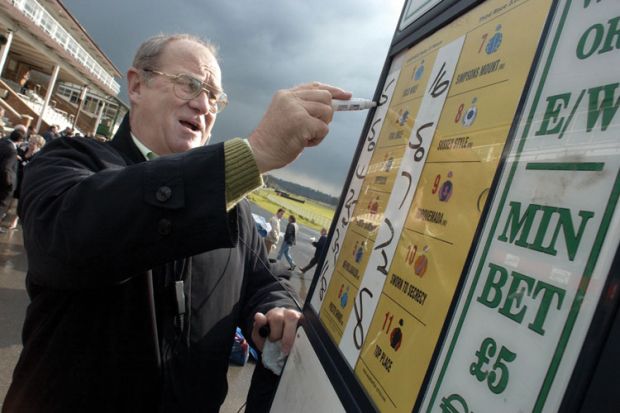Source: Alamy
What are the odds? By 2050 will RAB still be a controversial topic or will it be long forgotten?
David Willetts has dismissed concerns over growing estimates of the multibillion-pound portion of student loans that will never be repaid as perplexing “agonising” over “strange figures”.
The universities and science minister also discussed the cross-subsidy of more expensive courses by those studying cheaper courses when he spoke at the Higher Education Policy Institute’s conference on 21 May. He stated that it was wrong to “use one discipline as a cash cow to subsidise others”.
The government’s estimate of the portion of loan outlay that will never be repaid by graduates – known as the resource accounting and budgeting (RAB) charge – has risen steadily from an initial 28 per cent to 45 per cent and is set to climb higher.
It is already close to the 48.6 per cent level at which consultants London Economics said there will have been no savings to the public purse from the trebling of fees and the slashing of direct grant.
The government must provide an allocation in its annual budget to cover the RAB charge on student loans, and many believe that the rise in that figure was a factor in recent cuts to the rest of the higher education budget.
Mr Willetts predicted that in 2050, “I don’t think you will be able to say ‘it’s shocking we finally had to write off 43 per cent of those loans that were made back in 2012’…[People in 2050] will be perplexed people ever got into this type of agonising about these strange figures produced every six months.”
He added: “I think the RAB charge debate has got rather out of hand.”
But Bahram Bekhradnia, Hepi president, who has led criticism of the government over the issue, said: “The RAB charge is not some sort of rarefied construction that doesn’t matter…It is not surprising that the minister wishes to obscure that fact, but it is so…The RAB charge has a real cost. Today.”
He added: “In [2050], people will be wondering not what all the fuss was about, but how the government miscalculated so badly, especially as Hepi and others have been telling them from the start that they had got it seriously wrong.”
Mr Willetts was taking part in an on-stage interview with Chris Cook, his former researcher who is now policy editor on BBC Two’s Newsnight. Mr Cook pointed out that fees paid by history students subsidise more expensive courses, asking Mr Willetts if he would like to see students’ fees ring-fenced.
“I don’t believe in specific ring-fencing,” Mr Willetts said. “I don’t want to send out a specific instruction to universities about what should happen. But the assumption behind the fees model is the resources available to educate that student.”
The minister continued that a portion of each student’s fees went towards access funding and also universities’ costs of borrowing for capital investment, “you could argue”. “But it’s not intended that thereafter…you use one discipline as a cash cow to subsidise others.”
Culture shift: students ‘taken to heart’ in £9K fees era
There has been a “culture shift” in universities towards putting students at their heart since the advent of £9,000 fees, according to government research.
The Department for Business, Innovation and Skills published an analysis of a survey of institutions and students’ representatives on 21 May. The research is likely to be interpreted as a valedictory attempt by David Willetts, the universities and science minister, to establish evidence of a shift in attitude among institutions under higher tuition fees.
There is speculation that Mr Willetts could be removed from his post in a forthcoming reshuffle, or that he may be in the running to become the UK’s next European Union Commissioner.
The report, Improving the Student Learning Experience – A National Assessment, looked at factors such as the availability and accessibility of teaching staff as well as assessment and feedback.
The research is based on completed responses from senior managers in 99 institutions and “student representatives” in students’ unions in 36.
“The main message emerging from the two surveys is that HEIs appear to have implemented widespread changes in the past two years,” the report says.
It adds: “The evidence points to widespread changes within higher education, including what could be considered a ‘culture shift’ among institutions towards increasingly putting the students at the centre of what the institution does and how decisions are made (broadly speaking, student representatives support the view that activities around the student voice and consultation with students have improved over the past two years).”
The report goes on to say that “the extent of the changes reported is striking: in all areas covered by the survey, both the HEIs and the student representatives consistently report recent tangible improvements within their institution in the past two years”.





